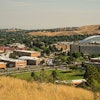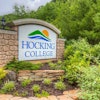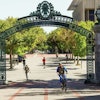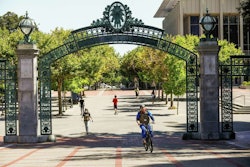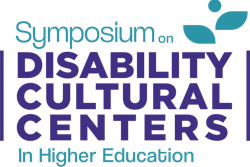In the beginning of 2020, before the pandemic moved everything online, Nate Tilton was on his way to a classroom labeled as accessible. Except, when Tilton arrived, he realized the accessible spot in the classroom was actually too tight to maneuver his power wheelchair. So, he spent the entirety of the lecture (and the following lectures, until the classrooms were switched) facing the wall.
Tilton has been a student at the University of California at Berkeley since 2018, and, through trial and error, word of mouth and his own exploration, he has come to know the campus well.
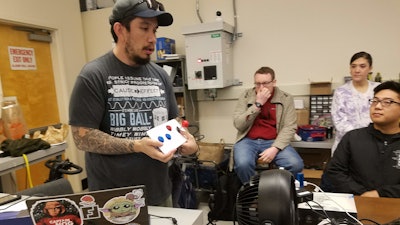 Nate Tilton, far left, holds up a low-cost
Nate Tilton, far left, holds up a low-cost
accessible gaming controller made at the lab.
“That’s why we’re doing this project,” says Tilton, referring to Radical Mapping, an open, crowd-sourced navigation app designed to pass on institutional knowledge to new students with mobility disabilities.
Tilton brought the idea to the Berkeley Disability Lab, where he works as lab manager. The beta launch for radical mapping is set to debut in the winter or spring for smartphones and desktops, and it will be free for users to access. After all, removing traditional barriers to accessibility is one of the reasons Dr. Karen Nakamura created the lab in 2018.
The Disability Lab is situated on the south side of Berkeley’s campus, where the terrain is flatter and there’s easy access to public transit. The lab, funded by Robert and Colleen Haas, is equipped with adjustable tables, work benches, tabletops, lighting intensity controls and equipment designed with disabled needs in mind. The lab is a nexus for the disability community, a place where their challenges and needs can meet with the resources Berkeley and Silicon Valley have available, says Nakamura.
Eliminating barriers to access
“Far too often, there’s a mismatch between community needs and what tech companies will do,” which leaves disabled persons without a real voice in the solutions that are meant to help them, says Nakamura.
“The disability community, including students, [needs] to provide more than just feedback,” she continues. “We need to develop the skills within the community to design things ourselves.”
The Disability Lab is a place where disabled and abled persons can come together and create “technical fluency.” Without that, Nakamura said, “you’re behind the curve.”
Low-cost is a key element to the lab’s work. Every project it tackles can ideally be replicated by the user with inexpensive, easily accessible materials found anywhere around the world.
The list of Disability Lab projects continues to grow. The team has developed an accessible game controller that comes together for under $20, a fraction of the cost of many controllers produced by gaming companies. They have made Arduinos, an open-source hardware and software single-board microcontroller, usable for the blind. They’re working on air purifiers and ventilators to help clear smoke from the air during fire season. They even designed a ramp for an elderly dog with arthritis who could no longer climb stairs.
The lab has hosted guests from Amazon, Uber and other Silicon Valley experts who have shared technological ideas or presented new challenges to students. But mostly, the work done in the lab is sourced directly from the disabled community itself. It’s a direct push back against universal design and the concept that disabilities need to be fixed.
“Universal design,” says Tilton, “is based on a singular body, typically a white disabled body. It erases people, essentially.”
An individual-centered approach
As an example, Tilton referenced a tool called Firefly, an attachment for wheelchair users that turns their chairs into motorized tricycles. In principle, says Tilton, it’s a great idea. “The problem is that it was designed to be used by a 6-foot-6 white dude with big hands. For me, I’m 5-foot-10, or for female identifying folks, that doesn’t work.”
This is why, says Tilton, the lab aims for Disability Centered Design (DCD).
“DCD centers the design — of whatever you’re doing, in policy, tech or in an institution — it centers marginalized people at the core and allows for the understanding that we are not a universal body, we’re all different, and that’s OK,” says Tilton.
Elizabeth Sherstinsky, an undergraduate senior at Berkeley, started working at the lab in January 2021. Her time in the lab has impacted the way she sees disability.
“There’s definitely medical issues alongside disability that arise from disability, but a medicalized framework says disability needs to be fixed. I don’t agree with that at this point,” she says.
“I see disability more as an identity-based trait of a person, similar to race, ethnicity, gender orientation,” she adds. Previously, Sherstinsky had spent time at the Bay Area Friendship Circle, where able-bodied and disabled teens were paired together for bonding activities.
“At the time,” she said, “I thought I was volunteering. Towards the end, I realized it was a cultural exchange.”
Fostering true community
Sherstinsky doesn’t have a specific title at the Disability Lab. Like so many who spend their time there, she volunteers to work on different projects. Cameron Garrett Johnson, a doctoral student at Berkeley who joined the lab this summer, says projects are tackled through a “super democratic, communal process.”
“We announce the goal first,” he says, “and all put our hands in. It’s why we’ve been able to get stuff done and push things out a lot quicker than I’ve experienced in a bureaucratized structure.”
Johnson met Tilton in a graduate class, where they bonded over similar backgrounds and a fascination with older cars.
“I was just kind of born tinkering with stuff,” Johnson says.
Tilton saw that Johnson’s electrical engineering skills could go a long way to help in the lab, so he encouraged Johnson to join. But that work, he says, is only half of what he does at the lab. “The other half is being part of the community and mentoring undergrads, making a more safe and equitable space for those of us on the margins,” he says.

“As an undergrad, I’ve always had diagnoses but was never a part of Disabled Students’ Program (DSP),” he says. DSP is the central hub for disability resources and accommodations on Berkeley’s campus.
“It was stigmatized, so many of us said, ‘OK, never mind, I’ll work twice as hard.’ The burden gets passed on to you because you’re so ashamed,” Johnson says.
But Johnson has met some extraordinary professors and individuals at Berkeley, people who became real mentors on his journey. He says he’s proud of the work he’s been able to do at the Disability Lab.
Johnson isn’t the only one Tilton recruited to join the lab. In fact, bringing students into the fold is something of a signature move for Tilton.
“He helped pull the community together,” said Nakamura, who also credits Tilton for pushing her into “new directions in thinking.”
That out-of-the-box thinking might be connected to Tilton’s unique journey. Tilton is a high school dropout. His experiences in the classroom had been so negative that the task of education became something he dreaded.
“At the time I didn’t realize, I had no idea, I was dyslexic,” he said. “I understand I’m neurodivergent now, but back then I didn’t,” he says. “A lot of times, they just saw a brown kid that was struggling.”
Things got so bad that Tilton recalled a teacher, who was much loved by students, telling him that he didn’t belong there. That was when he dropped out.
In 2005, he joined the California Army National Guard. The Army helped Tilton discover that he was not only capable but also talented. He served four tours, twice in Iraq and twice in Afghanistan, learning leadership skills and creative thinking, all things that have helped him in the lab. But his deployment also left him with PTSD, TBI (traumatic brain injury) as well as neck and back issues. In 2018, the same year he started at Berkeley, he experienced a neurological event that weakened the left side of his body. Since that time, he’s relied on assistance to get around.
“At some point in someone’s life, they may become disabled,” says Tilton. “That’s why we do the work we’re doing [at the lab].”
Outside the lab, Tilton’s research focuses on the care of disabled veterans who live near under-resourced VA hospitals. In particular, he had focused on the unique community of 24,000 veterans living in Guam.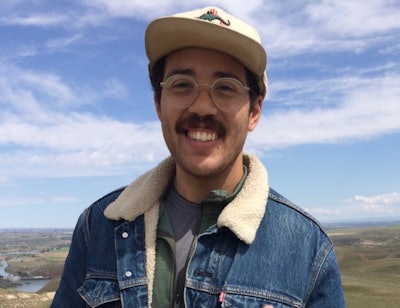 Cameron Johnson
Cameron Johnson
Christian Leycam also served in the Army. He first met Tilton in an anthropology course in 2019. Leycam could tell right away that Tilton was a veteran. “You just know, right off the bat,” says Leycam.
Leycam had previously been a member of the Center for Accessible Technology at Berkeley. But meeting Tilton made him want to explore creating solutions with disability at the center, so he switched labs.
Leycam has gone on to San Jose State University for his graduate degree, but he still plans on commuting to the lab to volunteer when he has the time.
“I really have to give a shout out to Nate. He’s very involved within the disability lab, but in addition he’s extremely involved in veterans’ rights communities,” said Leycam. “He’s gone out to D.C., spoken in front of Congress. He’s done amazing things, in terms of advocacy. Having him as the leader in our lab with Karen — they provide outstanding leadership.”
Tilton went to Washington, D.C., to advocate for parents of children with disabilities; Tilton has three children, one of whom is autistic. While there, he met with Rhode Island Representative Jim Langevin, who uses a motorized wheelchair.
“The chair was really neat and could stand up and do all this cool stuff,” said Tilton.
Tilton asked Langevin two questions. The first question was, how much did it cost? Langevin answered: about $100,000.
“Then I asked, ‘Is it waterproof?’ He said, 'No',” Tilton remembers. “What hope is there for the rest of us when a congressional representative can’t even get a waterproof chair?”
So, Tilton went back to the Disability Lab and started working. He and his lab fellows helped design a cost-effective, waterproofing system for the controllers on motorized chairs. They used foam, plastic, cloth, sewing skills and patience. Eventually, they created a low-cost, easily replicable method of waterproofing the controls on a powerchair.
Whatever project is being worked on, Nakamura and Tilton make sure that everyone, no matter what their ability or disability, can contribute. When Hari Srinivasan first came to the lab, he wondered how he could contribute as a non-speaking autistic with poor fine motor skills.
“I thought maybe I would just be the ideas guy in the group, a role I have taken on in the past,” he wrote. “However, Professor Nakamura quickly found a niche for me that takes advantage of my writing skill set. She essentially tailored a new role for me.”
Tilton credits Nakamura with helping him transition from military life to the life of a veteran. “She’s been a big help in my understanding my role as a disabled person,” he says.
That role involves the creation of a community. “On Twitter, I see a lot of disabled graduates and undergraduates, they’re like, ‘I’m in this lab and it’s inaccessible.’ And I feel for them,” says Tilton.
“In my lab, we take into consideration your disabilities. You need extra time? Don’t worry about it. It’s a place of growth and not a place of stress. You won’t find that often in places of academia.”
This article originally appeared in the September 16, 2021 edition of Diverse. Read it here.


